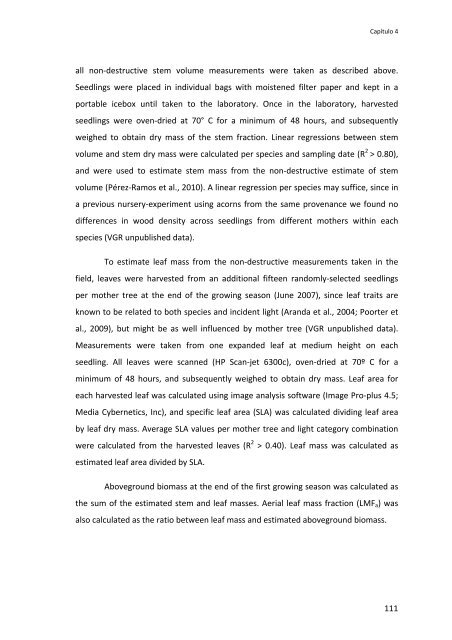Establecimiento de cuatro especies de Quercus en el sur de la ...
Establecimiento de cuatro especies de Quercus en el sur de la ...
Establecimiento de cuatro especies de Quercus en el sur de la ...
You also want an ePaper? Increase the reach of your titles
YUMPU automatically turns print PDFs into web optimized ePapers that Google loves.
Capítulo 4<br />
all non‐<strong>de</strong>structive stem volume mea<strong>sur</strong>em<strong>en</strong>ts were tak<strong>en</strong> as <strong>de</strong>scribed above.<br />
Seedlings were p<strong>la</strong>ced in individual bags with moist<strong>en</strong>ed filter paper and kept in a<br />
portable icebox until tak<strong>en</strong> to the <strong>la</strong>boratory. Once in the <strong>la</strong>boratory, harvested<br />
seedlings were ov<strong>en</strong>‐dried at 70° C for a minimum of 48 hours, and subsequ<strong>en</strong>tly<br />
weighed to obtain dry mass of the stem fraction. Linear regressions betwe<strong>en</strong> stem<br />
volume and stem dry mass were calcu<strong>la</strong>ted per species and sampling date (R 2 > 0.80),<br />
and were used to estimate stem mass from the non‐<strong>de</strong>structive estimate of stem<br />
volume (Pérez‐Ramos et al., 2010). A linear regression per species may suffice, since in<br />
a previous nursery‐experim<strong>en</strong>t using acorns from the same prov<strong>en</strong>ance we found no<br />
differ<strong>en</strong>ces in wood <strong>de</strong>nsity across seedlings from differ<strong>en</strong>t mothers within each<br />
species (VGR unpublished data).<br />
To estimate leaf mass from the non‐<strong>de</strong>structive mea<strong>sur</strong>em<strong>en</strong>ts tak<strong>en</strong> in the<br />
fi<strong>el</strong>d, leaves were harvested from an additional fifte<strong>en</strong> randomly‐s<strong>el</strong>ected seedlings<br />
per mother tree at the <strong>en</strong>d of the growing season (June 2007), since leaf traits are<br />
known to be r<strong>el</strong>ated to both species and inci<strong>de</strong>nt light (Aranda et al., 2004; Poorter et<br />
al., 2009), but might be as w<strong>el</strong>l influ<strong>en</strong>ced by mother tree (VGR unpublished data).<br />
Mea<strong>sur</strong>em<strong>en</strong>ts were tak<strong>en</strong> from one expan<strong>de</strong>d leaf at medium height on each<br />
seedling. All leaves were scanned (HP Scan‐jet 6300c), ov<strong>en</strong>‐dried at 70º C for a<br />
minimum of 48 hours, and subsequ<strong>en</strong>tly weighed to obtain dry mass. Leaf area for<br />
each harvested leaf was calcu<strong>la</strong>ted using image analysis software (Image Pro‐plus 4.5;<br />
Media Cybernetics, Inc), and specific leaf area (SLA) was calcu<strong>la</strong>ted dividing leaf area<br />
by leaf dry mass. Average SLA values per mother tree and light category combination<br />
were calcu<strong>la</strong>ted from the harvested leaves (R 2 > 0.40). Leaf mass was calcu<strong>la</strong>ted as<br />
estimated leaf area divi<strong>de</strong>d by SLA.<br />
Aboveground biomass at the <strong>en</strong>d of the first growing season was calcu<strong>la</strong>ted as<br />
the sum of the estimated stem and leaf masses. Aerial leaf mass fraction (LMF a ) was<br />
also calcu<strong>la</strong>ted as the ratio betwe<strong>en</strong> leaf mass and estimated aboveground biomass.<br />
111

















